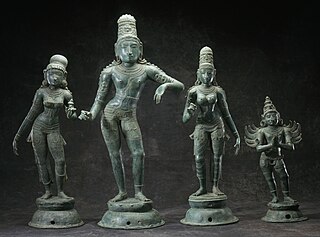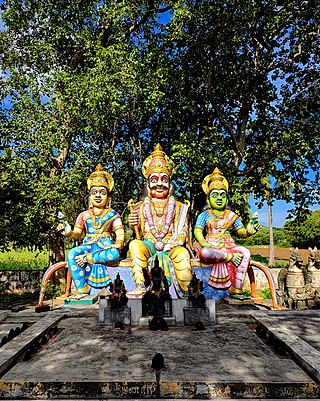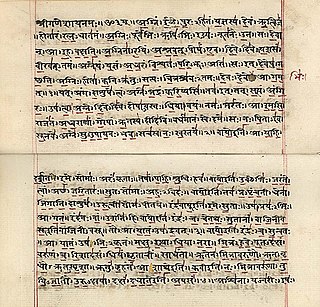Hinduism is an Indian religion or dharma, a religious and universal order by which its followers abide. The word Hindu is an exonym, and while Hinduism has been called the oldest religion in the world, it has also been described as sanātana dharma, a modern usage, based on the belief that its origins lie beyond human history, as revealed in the Hindu texts. Another endonym for Hinduism is Vaidika dharma.

Indian religions, sometimes also termed Dharmic religions or Indic religions, are the religions that originated in the Indian subcontinent. These religions, which include Buddhism, Hinduism, Jainism, and Sikhism, are also classified as Eastern religions. Although Indian religions are connected through the history of India, they constitute a wide range of religious communities, and are not confined to the Indian subcontinent.

Indra is the king of the devas and Svarga in Hinduism. He is associated with the sky, lightning, weather, thunder, storms, rains, river flows, and war.
Śruti or shruti in Sanskrit means "that which is heard" and refers to the body of most authoritative, ancient religious texts comprising the central canon of Hinduism. Manusmriti states: Śrutistu vedo vijñeyaḥ meaning, "Know that Vedas are Śruti". Thus, it includes the four Vedas including its four types of embedded texts—the Samhitas, the Upanishads, the Brahmanas and the Aranyakas.
Shudra or Shoodra is one of the four varnas of the Hindu caste and social system in ancient India. Some sources translate it into English as a caste, or as a social class. Theoretically, Shudras constituted a class like workers.

Yajna in Hinduism refers to any ritual done in front of a sacred fire, often with mantras. Yajna has been a Vedic tradition, described in a layer of Vedic literature called Brahmanas, as well as Yajurveda. The tradition has evolved from offering oblations and libations into sacred fire to symbolic offerings in the presence of sacred fire (Agni).
The Atharvaveda or Atharva Veda or Atharvana Veda is the "knowledge storehouse of atharvāṇas, the procedures for everyday life". The text is the fourth Veda, and is a late addition to the Vedic scriptures of Hinduism.

The Vedas are a large body of religious texts originating in ancient India. Composed in Vedic Sanskrit, the texts constitute the oldest layer of Sanskrit literature and the oldest scriptures of Hinduism.

Āryāvarta is a term for the northern Indian subcontinent in the ancient Hindu texts such as Dharmashastras and Sutras, referring to the areas of the Indo-Gangetic Plain and surrounding regions settled by Indo-Aryan tribes and where Indo-Aryan religion and rituals predominated. The limits of Āryāvarta extended over time, as reflected in the various sources, as the influence of the Brahmanical ideology spread eastwards in post-Vedic times.

The history of Hinduism covers a wide variety of related religious traditions native to the Indian subcontinent. It overlaps or coincides with the development of religion in the Indian subcontinent since the Iron Age, with some of its traditions tracing back to prehistoric religions such as those of the Bronze Age Indus Valley Civilisation. Hinduism has been called the "oldest religion" in the world, but scholars regard Hinduism as a relatively recent synthesis of various Indian cultures and traditions, with diverse roots and no single founder, which emerged around the beginning of the Common Era.

Śrauta is a Sanskrit word that means "belonging to śruti", that is, anything based on the Vedas of Hinduism. It is an adjective and prefix for texts, ceremonies or person associated with śruti. The term, for example, refers to Brahmins who specialise in the śruti corpus of texts, and Śrauta Brahmin traditions in modern times can be seen in Kerala and Coastal Andhra.

The Smartatradition, also called Smartism, is a movement in Hinduism that developed and expanded with the Puranas genre of literature. It reflects a synthesis of four philosophical strands, namely Uttara Mīmāṃsā, Advaita, Yoga, and theism. The Smarta tradition rejects theistic sectarianism, and is notable for the domestic worship of five shrines with five deities, all treated as equal – Ganesha, Shiva, Shakti, Vishnu and Surya. The Smarta tradition contrasted with the older Shrauta tradition, which was based on elaborate rituals and rites. There has been a considerable overlap in the ideas and practices of the Smarta tradition with other significant historic movements within Hinduism, namely Shaivism, Brahmanism, Vaishnavism, and Shaktism.

A śramaṇa is a person "who labours, toils, or exerts themselves for some higher or religious purpose" or "seeker, one who performs acts of austerity, ascetic". The śramaṇa tradition includes primarily Jainism, Buddhism, and others such as the Ājīvika.

Dhyāna in Hinduism means contemplation and meditation. Dhyana is taken up in Yoga practices, and is a means to samadhi and self-knowledge.

Buddhism and Hinduism have common origins in the culture of Ancient India. Buddhism arose in the Gangetic plains of Eastern India in the 5th century BCE during the Second Urbanisation. Hinduism developed as a fusion or synthesis of practices and ideas from the ancient Vedic religion and elements and deities from other local Indian traditions.
Indigenous Aryanism, also known as the Indigenous Aryans theory (IAT) and the Out of India theory (OIT), is the conviction that the Aryans are indigenous to the Indian subcontinent, and that the Indo-European languages radiated out from a homeland in India into their present locations. It is a "religio-nationalistic" view on Indian history, and propagated as an alternative to the established migration model, which considers the Pontic–Caspian steppe to be the area of origin of the Indo-European languages.

The Vedic period, or the Vedic age, is the period in the late Bronze Age and early Iron Age of the history of India when the Vedic literature, including the Vedas, was composed in the northern Indian subcontinent, between the end of the urban Indus Valley Civilisation and a second urbanisation, which began in the central Indo-Gangetic Plain c. 600 BCE. The Vedas are liturgical texts which formed the basis of the influential Brahmanical ideology, which developed in the Kuru Kingdom, a tribal union of several Indo-Aryan tribes. The Vedas contain details of life during this period that have been interpreted to be historical and constitute the primary sources for understanding the period. These documents, alongside the corresponding archaeological record, allow for the evolution of the Indo-Aryan and Vedic culture to be traced and inferred.

The early Dravidian religion constituted a non-Vedic, pre-Indo-Aryan, indigenous religion practiced by Dravidian peoples in the Indian subcontinent that they were either historically or are at present Āgamic. The Agamas are non-Vedic in origin, and have been dated either as post-Vedic texts, or as pre-Vedic compositions. The Agamas are a collection of Tamil and Sanskrit scriptures chiefly constituting the methods of temple construction and creation of murti, worship means of deities, philosophical doctrines, meditative practices, attainment of sixfold desires and four kinds of yoga. The worship of tutelary deities and sacred flora and fauna in Hinduism is also recognized as a survival of the pre-Vedic Dravidian religion. Dravidian linguistic influence on early Vedic religion is evident; many of these features are already present in the oldest known Indo-Aryan language, the language of the Rigveda, which also includes over a dozen words borrowed from Dravidian. The linguistic evidence for Dravidian impact grows increasingly strong as one moves from the Samhitas down through the later Vedic works and into the classical post-Vedic literature. This represents an early religious and cultural fusion or synthesis between ancient Dravidians and Indo-Aryans that went on to influence Indian civilisation.

The Rigveda or Rig Veda is an ancient Indian collection of Vedic Sanskrit hymns (sūktas). It is one of the four sacred canonical Hindu texts (śruti) known as the Vedas. Only one Shakha of the many survive today, namely the Śakalya Shakha. Much of the contents contained in the remaining Shakhas are now lost or are not available in the public forum.

Greater Magadha is a theory in the studies of the ancient history of India, introduced by Johannes Bronkhorst. It refers to the non-Vedic political and cultural sphere that developed in the lower Gangetic plains, east of the Vedic heartland and roughly corresponding to the region of the later Magadha empire.




















